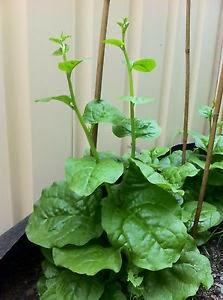 Alugbati (Basella alba), also called Indian spinach, malabar spinach and vine spinach, is an edible leafy plant popular in the Philippines. It grows best in hot weather, including summertime in Sunset's Climate Zones 3 through 24. Gardeners should plant it indoors during cool weather or outdoors after the soil temperatures reach 65 to 75 degrees Fahrenheit and nighttime temperatures are above 58 F. Since it is a climbing vine, it grows best with a trellis. It also prefers full sunlight and consistently moist soil. You can grow alugbati from seeds or from cuttings of an existing plant.
Alugbati (Basella alba), also called Indian spinach, malabar spinach and vine spinach, is an edible leafy plant popular in the Philippines. It grows best in hot weather, including summertime in Sunset's Climate Zones 3 through 24. Gardeners should plant it indoors during cool weather or outdoors after the soil temperatures reach 65 to 75 degrees Fahrenheit and nighttime temperatures are above 58 F. Since it is a climbing vine, it grows best with a trellis. It also prefers full sunlight and consistently moist soil. You can grow alugbati from seeds or from cuttings of an existing plant.Preparing the Soil
1
2
Add lime to raise the soil pH or sulfur to lower the soil pH, as needed. Apply any necessary additive at the rate indicated in the manufacturer's instructions. Soil pH additives generally come with instructions explaining how much to use to raise or lower the pH of a given garden area by a specific amount.
3
Add compost or other organic matter to the soil. Alugbati grows best in soils high in organic matter. Compost also improves soil moisture retention and drainage, helping to create the moist and loamy soil that this spinach prefers. Add at least a couple of inches of compost to the surface of the soil and mix it into the native soil with a tiller. Inland soils tend to be heavier than coastal soils, so they can use up to 6 inches of compost.
Planting from Cuttings
1
2
Soak the cuttings in water overnight or keep them in a dark and damp space for a day or two.
3
Plant the cuttings on hills or in rows. Space small hills six to eight inches apart and put three or four cuttings on each hill. Alternatively, space rows eight to 12 inches apart, with the cuttings spaced about eight inches apart.
4
Water the cuttings immediately and continue to keep the soil moist.
Planting from Seed
1
Scarify the seeds by using sandpaper or a knife to cut the outer seed coat.
2
Plant the seeds directly outside after soil temperatures have warmed to the minimum temperature required for germination of 65 F. Plant them about 1/4 inch deep in rows spaced about eight inches apart. Alternatively, spread seeds all across the soil and then thin the seedlings later so that they are spaced about eight inches apart.
3
Keep the soil consistently moist. If the soil dries out, the plants can flower, which makes the leaves taste bitter.

